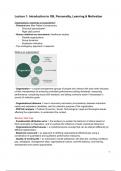Samenvatting
Samenvatting/Summary - Organizational Behavior
- Instelling
- Tilburg University (UVT)
Samenvatting van het vak Organizational Behavior. Onderdeel van de bachelor Organisatiewetenschappen aan de universiteit van Tilburg. Gaat over onder andere, teamwork, power and conflict, groups and teams. Summary of the course Organizational Behavior as part of the bachelors Organization Studies ...
[Meer zien]




